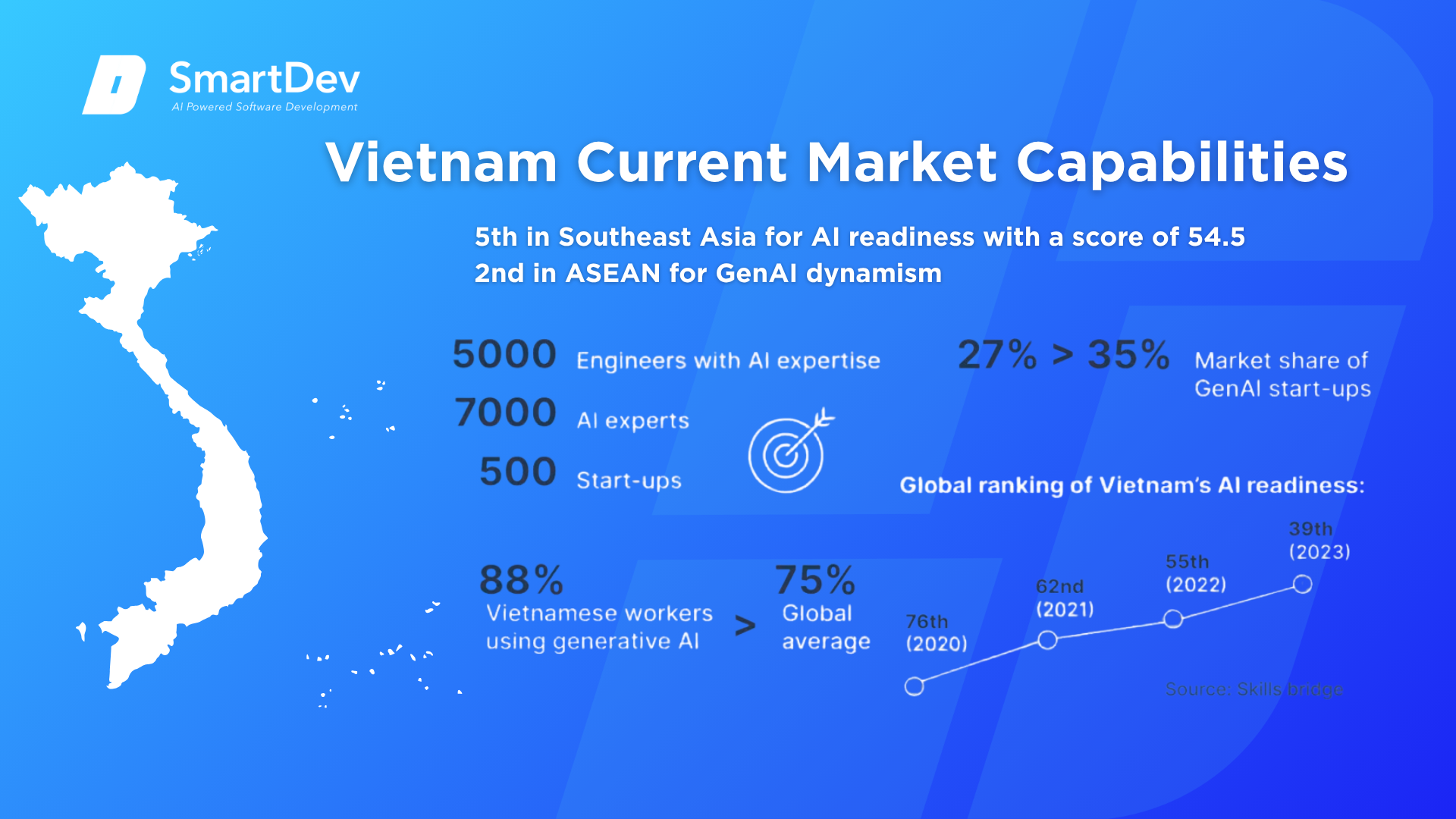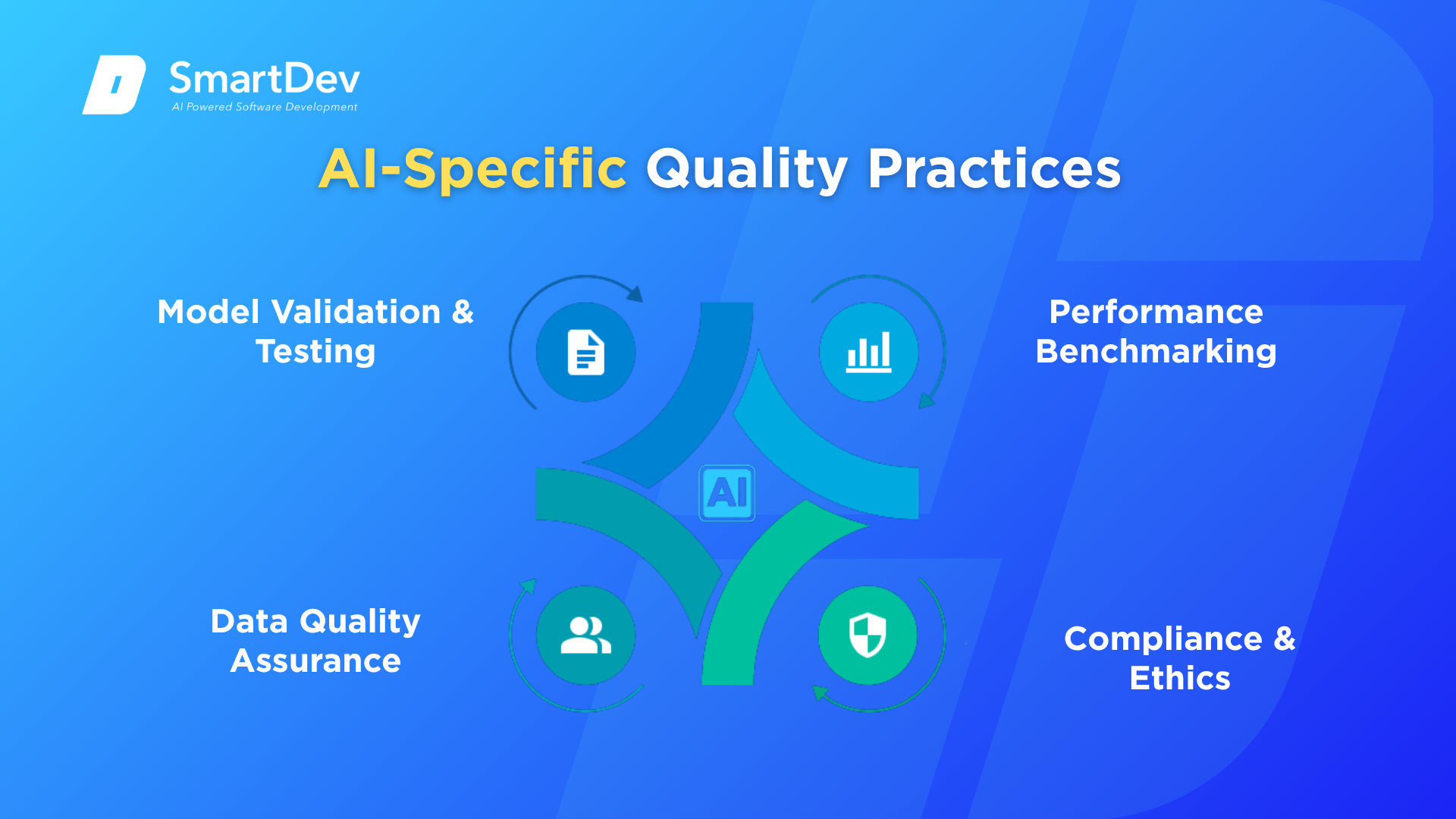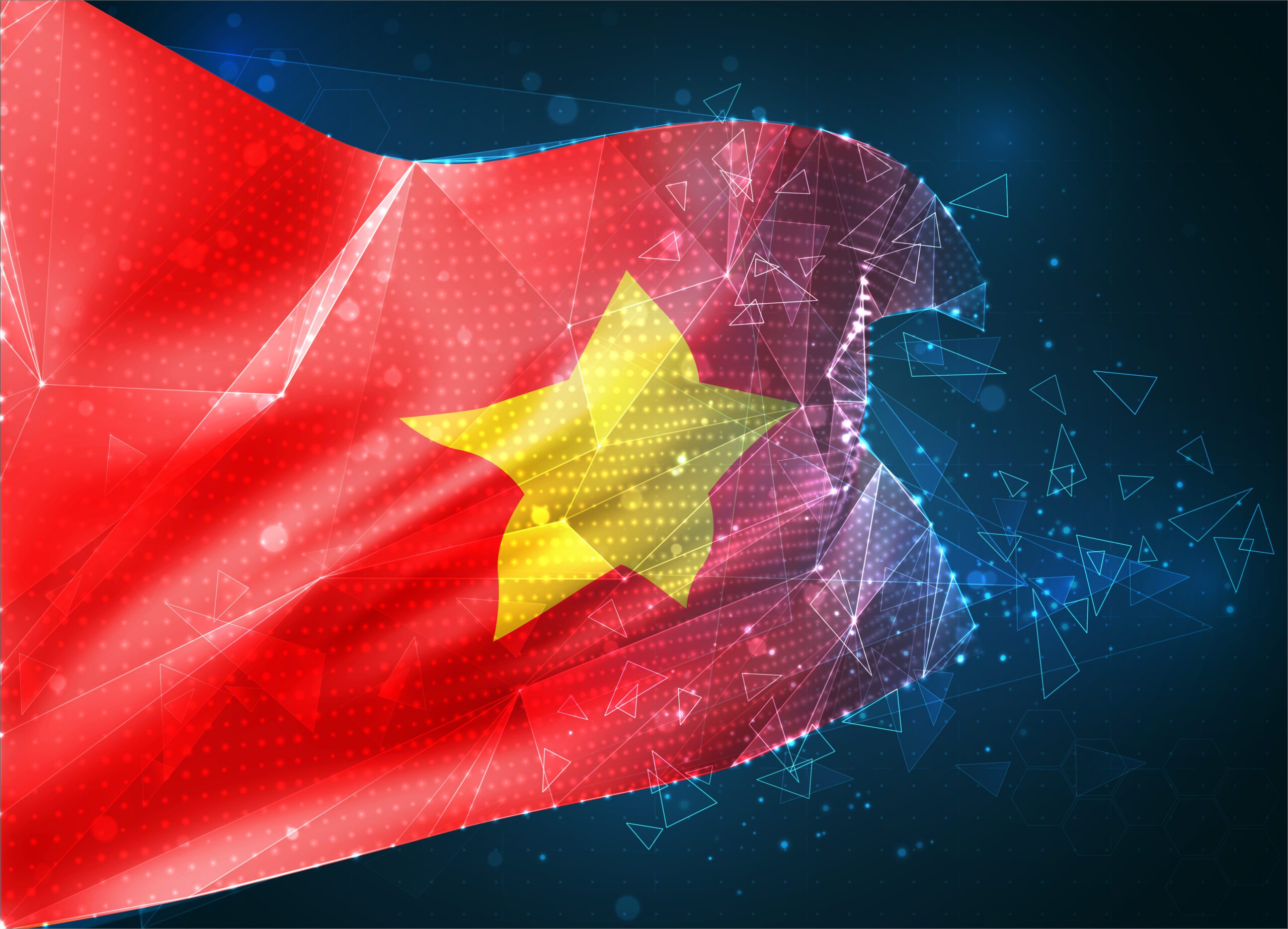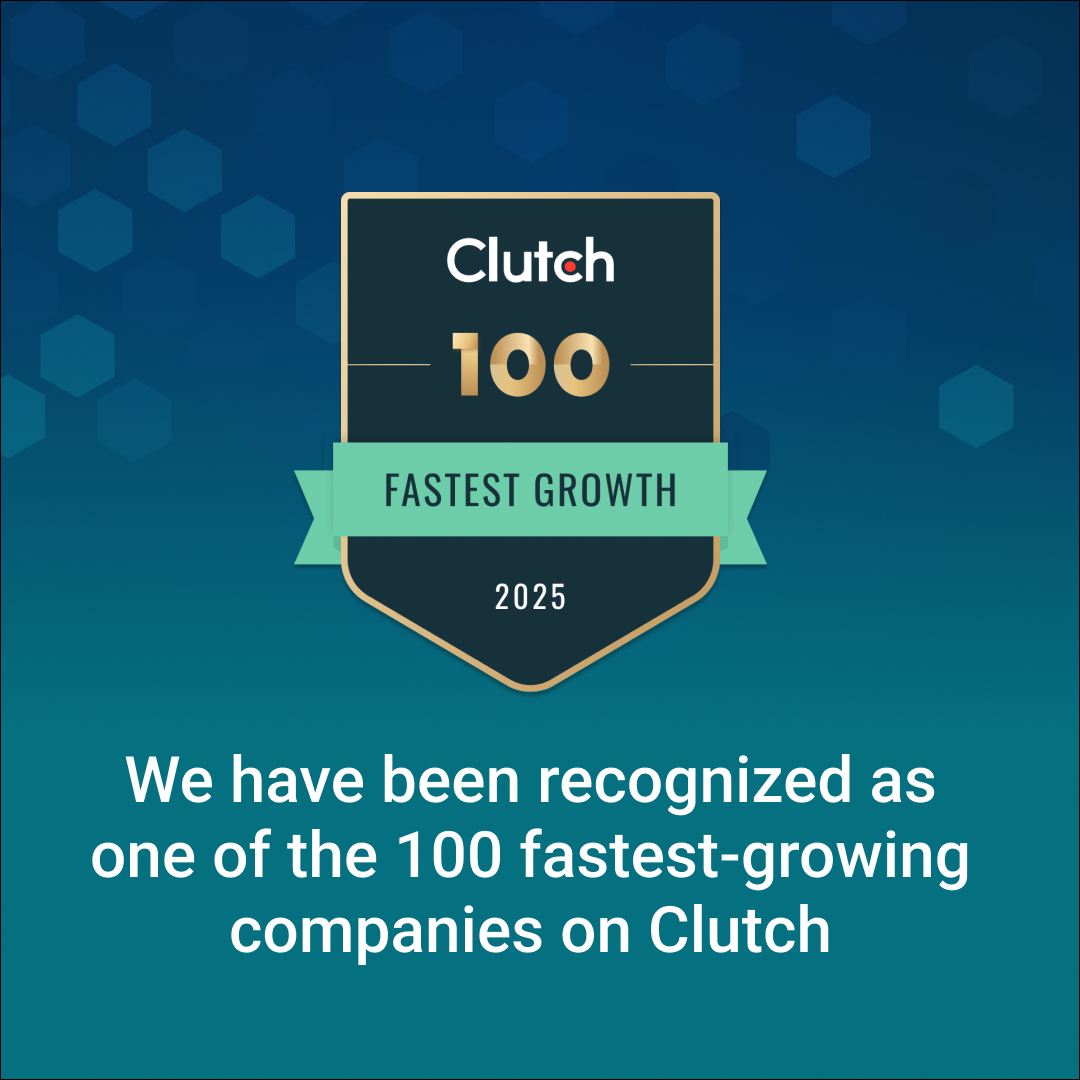Global enterprises face an unprecedented challenge: the demand for artificial intelligence talent dramatically outpaces supply. A report by McKinsey reveals that nearly 78% of organizations have incorporated AI into their business processes, yet the talent shortage remains acute across Silicon Valley, London, and Toronto. This creates a compelling paradox; companies desperately need AI expertise but cannot afford the escalating costs in traditional tech hubs.
Enter Vietnam AI hub solutions. While Silicon Valley junior developers command $180,000-$220,000 annually, their Vietnamese counterparts with equivalent expertise earn $20,000-$28,000 – a 87% cost reduction while maintaining enterprise-grade quality. This isn’t a story about compromising standards for savings; it’s about discovering where exceptional talent, economic efficiency, and rigorous quality coexist.
Vietnam’s emergence as Southeast Asia’s AI outsourcing epicenter represents the most significant shift in global AI development distribution since the rise of Indian IT services. Yet unlike India’s generalist approach or Singapore’s premium positioning, Vietnam has engineered a unique value proposition: specialized AI expertise delivered at emerging-market pricing with ISO 9001 and CMMI-certified quality standards.
This comprehensive analysis explores why Vietnamese AI talent has become indispensable to forward-thinking organizations, how Vietnam AI development delivers measurable ROI, and why enterprises worldwide are reconsidering their outsourcing strategies to include offshore AI development Vietnam operations.

Why Vietnam Stands Apart in Southeast Asia’s AI Landscape
The Regional AI Context
Southeast Asia AI outsourcing has become increasingly competitive as nations recognize AI as a strategic priority. However, the region’s AI ecosystem remains fragmented, with each country pursuing distinct strategies.
Singapore represents the premium positioning: 44% of Southeast Asia’s traditional AI startups originate there, driven by government incentives, established infrastructure, and first-mover advantage. Yet Singapore’s AI services command premium pricing-$80-$150 per engineering hour-creating barriers for mid-market and startup enterprises.
Indonesia possesses the largest tech talent pool in Southeast Asia, but lacks the formalized AI training infrastructure and government-backed initiatives necessary for coordinated ecosystem development. The Philippines excels in business process outsourcing (BPO) but remains less focused on specialized AI development.
Vietnam, meanwhile, has engineered a distinctly different approach. Rather than competing on premium brand recognition or BPO volume, Vietnam has positioned itself as Southeast Asia’s AI development specialist through three synchronized initiatives: a national AI strategy with government backing, targeted talent pipeline acceleration, and deliberate quality standard adoption across its outsourcing industry.
Government Strategy: The National AI Roadmap
Vietnam’s Politburo approved the National Strategy on AI targeting 2030, establishing an explicit vision: Vietnam will rank among the top four AI countries in ASEAN and the top 50 globally. This isn’t aspirational marketing—it’s backed by concrete resource allocation.
The strategy establishes clear metrics: developing ten prominent AI “trademarks” (recognized Vietnamese AI brands and solutions), establishing three national big data centers and high-performance computing facilities, and creating 50 interconnected open datasets accessible across economic sectors. Additionally, Vietnam targets 8,000 AI graduates annually by 2030, scaling to 15,000 by 2035.
This centralized strategy differs fundamentally from Singapore’s market-driven approach or India’s decentralized private-sector leadership. Vietnam has effectively decided to treat AI development as critical national infrastructure, comparable to earlier decisions regarding semiconductor manufacturing or automotive production.
The Vietnam AI Academy, established through partnership between the government, Hanoi University of Science and Technology (HUST), and NVIDIA, exemplifies this approach. The program trains 2,000 learners in year one, scaling to 6,000 in year two and 8,000-10,000 thereafter. This represents institutionalized, internationally-standardized AI education—not private bootcamps.
Why This Matters for Vietnam AI Hub Positioning
These strategic decisions create tangible advantages for enterprises seeking offshore AI development Vietnam partnerships:
- Predictable talent supply: Rather than competing for limited freelance talent, enterprises can access structured talent pipelines with known training standards and internationally recognized certifications.
- Quality consistency: Government-backed training programs ensure curriculum alignment with industry standards, reducing the variance in skill levels that plague other offshore markets.
- Regulatory alignment: National strategy creates policy stability—AI development is unlikely to suddenly become a deprioritized sector, as might occur in markets driven by fashion rather than government direction.
- Infrastructure investment: The planned computing centers and datasets reduce bottlenecks that plague development in regions relying entirely on private-sector infrastructure.

Examining the Competitive Edge of Vietnamese AI Talent
Demographics: The Fundamental Advantage
Vietnam’s population structure provides an underappreciated but critical advantage for Vietnamese AI talent development. Seventy percent of Vietnam’s 98 million residents are under 35 years old, with a median age of just over 30 years. This demographic composition ensures a continuous, abundant pipeline of early-career professionals ready for intensive skill development.
Contrast this with Japan (median age 48), South Korea (42), or even Singapore (41). Vietnam’s young population isn’t simply larger—it’s fundamentally different in its capacity for rapid workforce transformation. A junior developer trained in Vietnam today remains early in a 40-year career arc, versus a mid-career developer retrained in an aging market.
Beyond raw demographics, Vietnam exhibits exceptional STEM performance. The country consistently ranks among the top performers in international mathematics and science assessments (TIMSS, PISA), with particular strength in mathematics. This reflects not just individual brilliance but systemic educational prioritization of STEM disciplines.
Education Infrastructure and Production Capacity
Vietnam’s university system includes 150+ institutions offering ICT (Information and Communication Technology) courses. Leading universities—Hanoi University of Science and Technology, Ho Chi Minh City University of Technology, and Vietnam National University—produce graduates with theoretical foundations comparable to leading regional universities.
Current capacity produces thousands of computer science and engineering graduates annually. The bottleneck isn’t education capacity but specialization: traditional universities produce generalist computer scientists, while AI-specific expertise requires additional training.
The Vietnam AI Academy directly addresses this gap. By 2030, the country targets 8,000 AI-specialized graduates annually—not simply computer scientists with AI exposure, but engineers trained specifically in machine learning, deep learning, natural language processing, and computer vision. The 2035 projection increases this to 15,000 AI graduates annually, representing approximately 15-20% of Asia’s total projected AI workforce.
Critically, 20% of these AI graduates are targeted to hold postgraduate degrees by 2030, increasing to 20% by 2035. This ensures a continuous supply of researchers and advanced practitioners, not merely entry-level practitioners.
Current Market Capabilities
Vietnam currently hosts approximately 300 recognized AI experts—researchers, senior architects, and thought leaders recognized across the international AI community. While this might seem modest, it represents significant concentration relative to population and economic scale.
Behind this leadership layer exists a substantial supporting infrastructure: 74,000 technology firms employ over 1 million IT professionals in Vietnam’s tech ecosystem. These firms serve as training grounds for emerging talent, with structured progression paths from junior developer to specialized expertise.
Vietnamese AI talent includes demonstrated expertise across key AI specializations:
- Machine Learning & Data Science: Teams experienced in model development, feature engineering, hyperparameter optimization, and production deployment. Vietnamese teams have successfully deployed ML systems at scale, understanding practical constraints that separate theoretical algorithms from production implementations.
- Natural Language Processing (NLP): This represents a particular Vietnamese strength. Vietnamese language (a tonal, monosyllabic language with grammatical structures distinct from European languages) requires specialized NLP approaches. Vietnamese teams routinely develop Vietnamese-language NLP systems for applications spanning chatbots, document processing, and sentiment analysis. This expertise transfers to other Southeast Asian languages, providing regional advantage.
- Computer Vision: Vietnamese teams demonstrate capabilities in image classification, object detection, semantic segmentation, and video analysis. Applications include manufacturing quality control, autonomous systems, and healthcare diagnostics.
- Cloud Platform Expertise: AWS, Google Cloud, and Azure certifications are standard across Vietnamese development teams, ensuring compatibility with enterprise infrastructure.

The Localization Advantage
An often-overlooked dimension of Vietnamese AI talent represents a strategic competitive advantage: deep understanding of Vietnamese market dynamics, consumer behavior, and regulatory environment.
Vietnamese AI startups have achieved notable success developing localized solutions for education, public administration, legal systems, and tax compliance. These solutions leverage Vietnamese language, cultural context, and regulatory understanding—assets that offshore teams without Vietnamese expertise cannot replicate.
For enterprises developing AI for Southeast Asian markets, Vietnamese teams provide built-in localization advantage. Rather than iterating through feedback loops with external consultants, teams understand local nuances inherently.
Addressing Talent Shortages: The 150,000-200,000 Gap
Vietnam currently faces an annual shortfall of 150,000-200,000 ICT workers across all specializations. For AI specifically, the gap is even more acute—demand for AI personnel is forecast to surge 74% between 2025 and 2030, while supply remains constrained.
However, this shortage paradoxically validates offshore AI development Vietnam as a strategic choice. Rather than competing in a talent market where even junior developers command premium salaries, enterprises can partner with dedicated Vietnamese teams at predictable pricing before global market forces fully arbitrage these wage differentials.
The timing window remains open but closing. Enterprises establishing partnerships with Vietnamese AI teams in 2025-2026 lock in cost structures and team dynamics before market escalation. Later entrants will face both higher costs and more constrained availability.
The Cost Architecture of Offshore AI Development Vietnam
Comprehensive Salary Benchmarking
The most frequently cited advantage of offshore AI development Vietnam centers on cost: Vietnamese developers command 60-80% lower compensation than Silicon Valley equivalents. But understanding this advantage requires examining the specific cost architecture.
Junior AI Developers (0-2 years experience):
- Vietnam: $20,000-$28,000 annually ($10-$14/hour)
- Silicon Valley: $180,000-$220,000 annually ($90-$110/hour)
- Differential: 87% savings
Mid-Level AI Specialists (2-5 years experience):
- Vietnam: $28,000-$40,000 annually ($14-$20/hour)
- Silicon Valley: $220,000-$320,000 annually ($110-$160/hour)
- Differential: 86% savings
Senior AI Engineers (5+ years, architectural responsibility):
- Vietnam: $40,000-$60,000 annually ($20-$30/hour)
- Silicon Valley: $300,000-$450,000 annually ($150-$225/hour)
- Differential: 85% savings
These differentials remain consistent across seniority levels, the advantage isn’t limited to entry-level positions but extends throughout the career spectrum. A senior architect capable of designing enterprise-scale AI systems earns 1/5 to 1/7 the compensation of equivalent Silicon Valley talent.
![]()
Hourly Rate Analysis for Project-Based Engagements
For organizations considering project-based outsourcing rather than full-time hiring, hourly rates provide more granular understanding:
Vietnam offshore hourly rates:
- Junior AI developers: $25-$35/hour
- Mid-level specialists: $35-$45/hour
- Senior architects: $45-$50+/hour
Comparable market rates:
- North America: $100-$200+/hour
- Hong Kong/Singapore: $80-$150/hour
- Eastern Europe: $60-$90/hour
Vietnam’s positioning creates 60-70% savings versus North America, 40-50% versus developed Asia-Pacific markets, and remains competitive with or slightly superior to Eastern Europe while offering cultural and timezone advantages over European providers.
Project Economics: Real Return on Investment
Understanding offshore AI development Vietnam requires examining complete project economics, not merely hourly rates. A comprehensive analysis includes recruitment, onboarding, management overhead, and quality assurance costs.
Example 1: European Fintech Platform
Challenge: Developing AI-powered customer onboarding platform combining identity verification, document processing, and anti-fraud detection.
Engagement structure: 5-person Vietnamese team (1 architect, 2 senior engineers, 2 mid-level developers), 6-month engagement.
Cost calculation:
- Personnel: 5 developers × 6 months × $3,500/month average = $105,000
- Project management overhead: $20,000
- Quality assurance and infrastructure: $15,000
- Total project cost: $140,000
Equivalent US-based team:
- Personnel: 5 developers × 6 months × $15,000/month average = $450,000
- Project management overhead: $35,000
- QA and infrastructure: $25,000
- Total project cost: $510,000
Savings: $370,000 (73% reduction)
Timeline to break-even: The Vietnamese team delivered equivalent milestones on identical schedule. At scale, this represents pure cost avoidance—the Swiss fintech achieved identical outcomes at dramatically lower cost.
Example 2: Swiss Financial Services AI Implementation
Challenge: Building fraud detection system using historical transaction data and behavioral patterns.
Structure: 3-person experienced Vietnamese team (2 senior engineers, 1 data scientist), indefinite engagement with evaluation milestone at 3 months.
Cost calculation:
- Year 1 annual cost: 3 developers × $50,000 average = $150,000
- Recruitment and onboarding: $8,000
- Infrastructure and tooling: $4,000
- Total first-year cost: $162,000, or $42,000 per developer annually
Equivalent US-based team:
- Annual cost: 3 developers × $320,000 average = $960,000
- Recruitment and onboarding: $45,000
- Infrastructure: $12,000
- Total first-year cost: $1,017,000, or $339,000 per developer annually
Savings: $855,000 first year (84% reduction)
The Vietnamese team completed equivalent development work, passed equivalent security audits, and integrated successfully with existing Swiss infrastructure. Long-term, the Swiss firm established a sustainable offshore AI development Vietnam partnership, with team stability and cost predictability unavailable in domestic market.
“Vietnam’s AI talent pool matches US standards in software engineering, with strong mathematical skills and increasing cloud certifications,” says Nguyen Le, COO at SmartDev.
Hidden Costs and Total Cost of Ownership
Enterprises comparing offshore AI development in Vietnam options must examine beyond hourly rates to understand total cost of ownership (TCO):
Recruitment and hiring costs:
- Vietnam: $2,000-$5,000 per developer (significantly lower due to abundant talent supply)
- Silicon Valley: $15,000-$30,000 per developer (search fees, relocation costs, signing bonuses)
Onboarding timeline:
- Vietnam: 2-4 weeks (rapid due to standardized training and cultural familiarity with outsourcing engagement models)
- Silicon Valley: 4-8 weeks (integration with existing culture, security clearances, setup delays)
Real estate and infrastructure:
- Vietnam: $200-$400 per developer monthly (office space, equipment)
- Silicon Valley: $1,500-$3,000 per developer monthly (premium office space, parking, facilities)
Benefits and overhead:
- Vietnam: 15-20% of base salary (health insurance, minimal pension obligations)
- Silicon Valley: 40-50% of base salary (healthcare, 401k matching, unlimited PTO, stock options)
Turnover and retention costs:
- Vietnam: 15-20% annual turnover (mid-market expectation with improving retention)
- Silicon Valley: 25-35% annual turnover (talent poaching, startup migration, burnout)
When accounting for these factors comprehensively, offshore AI development Vietnam improves total cost of ownership by 70-85%, not merely the hourly rate differential.
![]()
Cost Trajectory and Future Projections
A critical consideration: will Vietnam’s cost advantage persist, or will wage inflation eliminate the differential?
Vietnamese developer salaries are projected to increase 10-20% annually through 2025-2030 as AI specialization accelerates demand. Simultaneously, US AI developer compensation is growing 32% annually, with specialized AI expertise (large language models, diffusion models, reinforcement learning) commanding 15-20% premiums over baseline AI development.
The math strongly favors Vietnam’s long-term positioning: Vietnam growing at 15% annually versus US growing at 32% annually creates a widening window. The cost differential will narrow (perhaps to 50-60% by 2030) but will likely remain substantial for 10+ years.
For enterprises deciding between domestic hiring and offshore AI development Vietnam partnerships in 2025-2026, locking in current cost structures before market escalation creates substantial long-term value.
Supercharge Your Business with Vietnam’s AI Talent
Vietnam is home to a young, dynamic workforce, with 70% of the population under 35, bringing fresh ideas and skills to the AI world. From machine learning to natural language processing, Vietnam’s AI experts are creating solutions that are not only innovative but also cost-effective.
At SmartDev, we connect you with this growing pool of talent to help you unlock faster, smarter, and more affordable AI solutions. Whether you’re aiming to scale, innovate, or transform your business with AI, Vietnam’s talent is the key to your success.
Ready to harness the power of Vietnam’s AI talent?
Quality Assurance and Enterprise-Grade Reliability
International Certification Framework
Southeast Asia AI outsourcing encompasses a quality spectrum from boutique shops to enterprise-grade operations. Vietnam’s leading providers operate at the premium end through rigorous certification and process discipline.
- ISO 9001 Certification (Quality Management Systems): Over 70% of Vietnam’s major software exporters maintain ISO 9001 certification, establishing baseline process discipline. Certified organizations document development processes, implement configuration management, maintain traceability from requirements to testing, and demonstrate continuous improvement.
- CMMI Certification (Capability Maturity Model Integration): Vietnam’s leading software export companies maintain CMMI Level 3 or higher certifications, positioning them above the median capability of global software organizations. CMMI Level 3 requires maturity across defined processes, documented procedures, standardized development approaches, and measurable quality metrics. Organizations at this level deliver predictable outcomes with reduced defect rates and improved project success.
- ISO/IEC 27001 Certification (Information Security Management): Critical for enterprise AI applications requiring data protection compliance, ISO/IEC 27001 certification ensures systematic information security, access controls, encryption standards, and incident response procedures.
These certifications aren’t mere credentials; they represent auditable, measurable process discipline. An enterprise selecting a certified Vietnam AI development partner can verify adherence to international standards through third-party audit records.
AI-Specific Quality Practices
Beyond general software quality, Vietnamese AI talent applies specialized quality practices essential for production AI systems:
Model Validation & Testing:
- Rigorous validation on holdout test datasets
- Cross-validation across multiple data splits
- Evaluation of model performance across demographic segments and edge cases
- Bias detection and fairness assessment
Data Quality Assurance:
- Training dataset validation ensuring accuracy and completeness
- Handling of missing values and outliers
- Verification of data labeling quality when working with supervised learning
- Detection of data leakage that can invalidate models
Performance Benchmarking:
- Comparison against baseline models and previous versions
- A/B testing in production environments
- Monitoring of model performance degradation over time
- Documentation of model assumptions and limitations
Compliance & Ethics:
- GDPR and PDPA compliance verification
- Fairness audits for bias and discrimination
- Explainability documentation for regulatory requirements
- Responsible AI practices aligned with enterprise policies

Real-World Performance Metrics
Vietnam’s quality performance demonstrates tangible results:
- Client Satisfaction Rate: 90% for completed outsourced projects (comparable to or exceeding global averages)
- Quality Benchmark Achievement: Over 70% of Vietnamese IT exports meet international quality benchmarks, a significant achievement given total export volume
- Defect Reduction: Organizations employing CMMI practices report 30-40% reductions in critical defects and 20-30% improvements in schedule predictability
- Rework Costs: Certified organizations maintain rework costs at 5-10% of project budgets, versus 15-25% common in less mature organizations
These metrics establish that offshore AI development Vietnam isn’t about accepting lower quality in exchange for cost reduction—rather, it achieves equivalent or superior quality at substantially lower cost.
The SmartDev Positioning – Market Education and Thought Leadership
Why Vietnam’s Position Elevates Dedicated Providers
SmartDev, as a Swiss-managed Vietnamese AI development provider, benefits substantially from Vietnam’s emerging positioning as Southeast Asia’s AI hub. The macro trend provides three distinct advantages:
Market education: As enterprises educate themselves about Vietnamese AI talent and offshore AI development Vietnam opportunities, they simultaneously develop sophistication about offshore engagement models. This creates demand for providers who understand both Vietnamese operational context and international enterprise requirements—precisely SmartDev’s positioning.
Quality verification: As more enterprises pursue Vietnam AI development partnerships, success stories accumulate. Each successful engagement provides evidence for subsequent enterprises considering similar moves. SmartDev’s track record becomes validated through broader market success.
Talent recruitment: As Southeast Asia AI outsourcing becomes recognized as legitimate (not discount) AI development, attracting top Vietnamese talent becomes easier. Developers increasingly see offshore engagement as career progression rather than compromise, enabling SmartDev to recruit and retain specialized talent.
Thought Leadership Positioning
The strategic rationale explicitly includes “thought leadership format builds authority beyond specific services.” This article and similar content positions SmartDev not merely as a service provider but as an authoritative voice on:
- Market trends: Understanding why Vietnam emerges as Southeast Asia’s AI development hub demonstrates expertise beyond service delivery.
- Enterprise buying dynamics: Articulating the talent-cost-quality trifecta addresses primary enterprise concerns, positioning SmartDev as understanding client psychology and priorities.
- Regulatory and operational context: Discussing government strategy, infrastructure investment, and local practices demonstrates operational sophistication unavailable from purely Western consultants.
- Talent development: Explaining training pipelines, certification frameworks, and developer growth prospects shows commitment to long-term partnership value creation beyond current project scope.
Broader Market Opportunity
Vietnam’s positioning as Vietnam AI hub creates expanding market opportunity:
- Enterprises not yet offshore: Companies still making “build versus outsource” decisions need education. Demonstrating how Vietnamese AI talent addresses their specific constraints (talent shortage, budget pressure, time-to-market) converts new customer segments.
- Enterprises considering other markets: Organizations evaluating India, Eastern Europe, or Philippines providers need comparative context. Articulating Vietnam’s specific advantages positions SmartDev as offering superior value proposition.
- Enterprises in later outsourcing stages: Organizations with successful offshore partnerships may consider expanding or shifting providers. Establishing SmartDev as thought leader (rather than competitor) creates conversion opportunity.

Why Vietnam Outpaces in Alternatives Competitive Positioning
Vietnam vs Singapore: Specialist vs Premium
Singapore represents the premium AI services positioning within Southeast Asia. With 44% of the region’s AI startups and decades of infrastructure investment, Singapore offers uncompromising quality and international prestige.
However, this positioning creates economic constraints. Singapore-based AI development costs $80-$150 per hour—substantially more than Vietnam but less than Silicon Valley. For enterprises with unlimited budgets, Singapore provides optimal choice. For organizations optimizing cost-effectiveness, Vietnam offers superior value.
Strategic distinction that Singapore excels for specialized, high-complexity AI research and premium advisory services. Vietnam excels for production AI systems requiring scalable team capacity at predictable pricing.
An enterprise might engage Singapore for AI strategy consulting and research, then partner with offshore AI development Vietnam for implementation—leveraging each market’s distinct advantages.
Vietnam vs India: Specialization vs Scale
India built the world’s largest IT services export industry through scale, breadth of services, and decades of relationship development. Indian IT companies employ millions, manage global accounts, and operate sophisticated delivery centers across multiple countries.
India’s primary weakness relative to Vietnam AI hub: generalist positioning. Indian IT vendors optimize for broad service portfolios (ERP, CRM, infrastructure, business processes) with AI as one offering among many. This generalism enables scale but reduces specialization.
Strategic distinction: India excels for comprehensive business transformation involving multiple technology domains. Vietnam excels for specialized AI expertise requiring focused capability.
An enterprise might engage TCS or Infosys for enterprise-wide transformation, then engage Vietnamese specialists for AI-specific components—leveraging India’s broad integration capabilities with Vietnam’s specialized expertise.
Vietnam vs Philippines: Infrastructure and Strategy
The Philippines possesses abundant English-speaking talent and established BPO relationships with US and Australian enterprises. However, Philippine AI development infrastructure remains less developed than Vietnam’s—there is no equivalent National Strategy on AI, and government support for AI development differs substantially from Vietnam’s coordination.
Strategic distinction: Philippines excels for customer service, data entry, and business process outsourcing. Vietnam excels for technical AI development requiring specialized expertise.
Regional Synthesis: Vietnam’s Optimal Position
Vietnam occupies a distinctive position within Southeast Asia’s AI landscape:
- More specialized than India (focused AI expertise vs generalist services)
- More cost-effective than Singapore (emerging market pricing vs premium positioning)
- More strategically coordinated than Philippines (government-backed initiatives vs market-driven development)
- More technically sophisticated than Indonesia (formalized training infrastructure vs emerging ecosystems)
This positioning explains why enterprises increasingly consider offshore AI development Vietnam as the optimal choice for balancing multiple constraints: specialized capability, cost efficiency, quality assurance, and strategic partnership value.

Implementation Framework – From Decision to Execution
Partnership Model Selection
Organizations pursuing Vietnamese AI talent should select engagement models matching their specific requirements:
- Staff Augmentation: Extending existing teams with Vietnamese developers for specific projects or skill gaps. Ideal for organizations with established processes who need temporary capacity expansion. Typical duration: 3-12 months.
- Dedicated Team: Establishing a dedicated offshore team reporting to client management, operating as extension of internal organization. Ideal for long-term AI initiatives with evolving requirements. Typical duration: 12+ months.
- Project-Based Outsourcing: Engaging Vietnamese team to deliver specific project with defined scope, timeline, and deliverables. Ideal for discrete initiatives with clear boundaries. Typical duration: 3-9 months.
Each model offers distinct advantages. Staff augmentation provides flexibility but requires strong local management. Dedicated teams enable deeper integration but require greater commitment. Project-based outsourcing minimizes commitment risk but can suffer from scope creep.
Selection Criteria for Vietnam AI Development Partners
Quality varies substantially within Vietnam’s offshore market. Distinguishing premium providers requires evaluating:
- Certifications: Verify ISO 9001, CMMI Level 3+, and ISO/IEC 27001 certifications through independent audit records, not merely provider claims.
- Portfolio & Case Studies: Request detailed case studies from similar projects. Ask for references you can contact independently. Evaluate project complexity, client profile similarity, and stated outcomes.
- Team Structure: Examine team composition, experience levels, and specialization focus. Understand management structure and communication protocols. Verify key personnel won’t be reassigned mid-project.
- Process Documentation: Request development process documentation, quality assurance procedures, and testing frameworks. Premium providers should articulate specific practices, not merely reference frameworks.
- Communication & Timezone: Evaluate communication cadence, timezone overlap for synchronous meetings, and language capabilities. Poor communication undermines offshore engagement value.
- Cultural Fit: Assess alignment with enterprise culture, decision-making styles, and work approaches. Offshore partnerships require higher tolerance for process discipline than collocated teams.
Risk Mitigation Strategies
Enterprises pursuing offshore AI development Vietnam should implement risk management:
- Pilot Projects: Begin with non-critical projects to evaluate team performance, compatibility, and process effectiveness before major commitments. Use 3-month pilots to establish trust and process alignment.
- Knowledge Transfer: Implement structured knowledge transfer ensuring project continuity if personnel changes occur. Document decisions, architecture rationale, and implementation choices.
- Redundancy: Build redundancy into critical components, avoiding single points of failure. Maintain access to code, documentation, and system design independent of individual team members.
- Escalation Paths: Establish clear escalation procedures for problems, timeline concerns, or quality issues. Define decision-making authority and communication protocols.
- Contract Structure: Implement milestone-based payment tied to deliverables, ensuring accountability and enabling course correction if engagement diverges from expectations.
Vietnam’s Trajectory Through 2030
Short-Term Evolution (2025-2027)
Vietnam’s Vietnam AI hub positioning will solidify through several concurrent developments:
- Talent Pipeline Acceleration: First full cohorts of intensive AI training programs will graduate, expanding specialized talent availability from current ~300 experts to thousands of trained practitioners. The Vietnam AI Academy will reach full operational capacity, producing 8,000+ annual graduates.
- Cost Window Optimization: Vietnamese AI developer salaries will increase 10-20% annually, while US AI salaries grow 32% annually. This creates an expanding cost differential window—organizations establishing Vietnamese partnerships now lock in favorable pricing before market escalation.
- Infrastructure Completion: National computing centers will come online, eliminating current infrastructure constraints for training and research. The 50 interconnected datasets will create substantial value for AI training and validation.
- Market Validation: GenAI startups engaging with Vietnamese development teams will accumulate success stories. Each successful engagement provides evidence for subsequent enterprises considering offshore partnerships.
Medium-Term Development (2027-2030)
Vietnam will achieve positioning as Southeast Asia’s AI development leader through:
- Scale Achievement: Vietnam will graduate 8,000 AI specialists annually and maintain 15,000+ mid-term AI professionals. This reaches critical mass for supporting enterprise-scale initiatives simultaneously.
- Infrastructure Maturity: Computing centers and datasets will reach operational capacity, enabling sophisticated research and development unavailable through private-sector infrastructure alone.
- International Recognition: Vietnam will achieve top-50 global ranking for AI capability, validated through research output, startup success, and enterprise deployment metrics. This international validation further accelerates enterprise adoption of offshore AI development Vietnam.
- Industry Specialization: Vietnamese teams will develop recognized expertise in specific domains—healthcare AI, financial services AI, manufacturing AI, agricultural technology. This specialization increases value proposition beyond general-purpose AI services.
Long-Term Vision (2030+)
By 2030, Vietnam will establish itself as:
- Global AI Development Partner: Vietnam will rank alongside established centers (US, China, UK) as legitimate source for serious AI development, not merely cost-optimization plays.
- Regional AI Hub: Singapore will maintain premium positioning for research and strategy; Vietnam will dominate production AI development across Southeast Asia.
- Specialized Innovation Center: Vietnamese teams will lead development in localized AI (Vietnamese language, Southeast Asian market adaptation), creating competitive advantage in regional markets.
- Sustained Cost Competitiveness: While wage differentials will narrow from current 85% to perhaps 50-60%, Vietnam will maintain substantive cost advantage indefinitely through population scale, continuous training pipelines, and infrastructure maturity.

Strategic Imperatives for 2025-2026
The convergence of Vietnam’s demographic advantages, strategic government initiative, infrastructure investment, talent pipeline acceleration, and proven quality standards creates a unique historical moment. Organizations that establish offshore AI development Vietnam partnerships in 2025-2026 capture several advantages:
- Locked-in Pricing: Cost structures established now will remain relatively stable even as market escalates. Early entrants secure lasting cost advantages.
- Team Continuity: As popular offshore destinations become congested, team allocation and continuity become constrained. Early entrants secure first access to specialized talent.
- Relationship Capital: Partnerships established early, before market saturation, develop deeper integration and relationship quality.
- Thought Leadership Position: Organizations that successfully leverage Vietnamese AI talent early can establish public recognition as forward-thinking, demonstrating market leadership to competitors and customers.
The question isn’t whether Vietnam AI hub will emerge as Southeast Asia’s primary AI development destination – government policy, demographic advantages, talent pipeline investment, and early market validation already confirm this trajectory. The question is whether your organization will participate in this transition, or observe from the sidelines.
Southeast Asia AI outsourcing has fundamentally shifted. Vietnamese AI talent has moved from emerging-market compromise to strategic necessity. Vietnam AI development represents not budget optimization but business optimization—delivering equivalent or superior outcomes at substantially lower cost, with greater predictability and strategic partnership value than traditional outsourcing markets.
The window for establishing advantageous positioning within offshore AI development Vietnam remains open. But as other enterprises recognize Vietnam’s advantages, available capacity will constrain, costs will escalate, and the fundamental value proposition will compress.
For enterprises seeking to build or expand AI capabilities at predictable cost with enterprise-grade quality and strategic partnership value, the decision becomes clear: Vietnam isn’t just an alternative to traditional tech hubs. For production AI development requiring scalable team capacity, specialized expertise, and long-term cost predictability, Vietnam is the optimal choice.
The future of AI development isn’t concentrated in Silicon Valley, Beijing, or London. It’s increasingly distributed across emerging markets with the right combination of talent, strategy, infrastructure, and cost efficiency. Vietnam has engineered precisely this combination.








